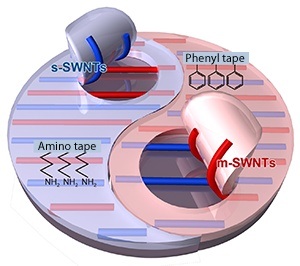| Sep 12, 2011 |
Separation of metallic and semiconducting carbon nanotubes by 'scotch tape'
|
|
(Nanowerk News) Single-walled carbon nanotubes (CNTs) have considerable potential for use in electronic devices such as field-effect transistors and solar cells. Research in this area of nanotechnology is hampered, however, by the difficulty in isolating the desired type of CNT from the two types — either semiconducting or metallic — that are generally formed during synthesis. As the performance of such devices is dependent on the purity of CNT type in different parts of the device structure, techniques for isolating these CNT types without breaking them or disrupting their alignment are of great interest.
|
|
Inspired by the Nobel Prize-winning research on the mechanical exfoliation of graphene using 'scotch tape', Jin Zhang and colleagues from Peking University in China, Williams College in the US and the Samsung Advanced Institute of Technology in Korea have now devised a method for the separation of semiconducting and metallic CNTs without damaging them ("Separation of Metallic and Semiconducting Single-Walled Carbon Nanotube Arrays by 'Scotch Tape'").
|
 |
| A schematic illustration of the separation of single-walled CNTs using amino- and phenyl-modified PDMS scotch tape.
|
|
The researchers used thin films of polydimethylsiloxane (PDMS) chemically modified with either amino or phenyl groups as a type of scotch tape to lift CNTs from the sapphire substrate on which they were prepared (see image). The amino-type scotch tape selectively removes semiconducting CNTs from a mixture of CNTs on the substrate surface, whereas the phenyl-type scotch tape selectively removes only metallic CNTs, without disturbing the CNTs left behind. "Compared with current separation methods based on selective adsorption, we have successfully extended the mechanism to a long nanotube system and controlled the formation of carbon nanotubes perfectly," says Zhang.
|
|
Field-effect transistors could be prepared using the scotch tape technique by lifting off the unwanted type of CNTs from the substrate, leaving only the desired CNTs with an undisturbed alignment. Using the scotch tape method in this way produced metallic CNT regions of 90% purity, and semiconducting CNT regions of 85% purity.
|
|
At present, this scotch tape method introduces a small amount of contamination from the modified PDMS films. In the future, Zhang and his colleagues hope to optimize the separation process by improving the separation efficiency and reducing or eliminating contamination. "We would also like to extend the method to the separation of CNTs of differing chirality," said Zhang.
|

